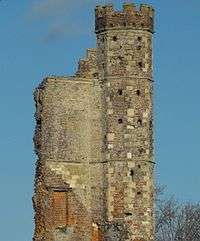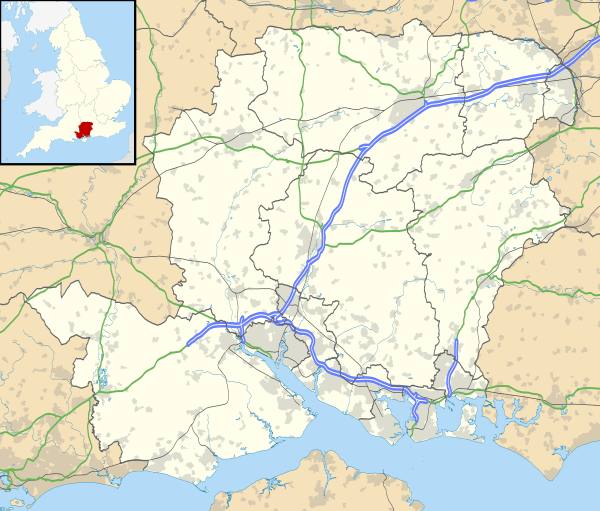Warblington Castle
| Warblington Castle | |
|---|---|
| Hampshire, England | |
 Part of the remains of Warblington Castle | |
 Warblington Castle | |
| Coordinates | 50°50′40″N 0°57′57″W / 50.8444°N 0.9659°WCoordinates: 50°50′40″N 0°57′57″W / 50.8444°N 0.9659°W |
| Grid reference | grid reference SU729055 |
| Type | Fortified manor house |
| Site information | |
| Condition | Ruined |
Warblington Castle or Warblington manor was a moated manor near Langstone in Hampshire that today consists of little more than one turret, part of the old gatehouse.
Details
Located near Langstone in Hampshire,[1] the site was originally home to a medieval manor.[2] It has been claimed that the manor received a licence to crenellate in 1340[2] but this is disputed.[3] The manor passed through several hands before coming into the possession of Richard Neville, 16th Earl of Warwick in the 15th century.[4] With the execution of Edward Plantagenet, 17th Earl of Warwick by Henry VII the manor was confiscated and passed to the crown.[4] In 1513 Henry VIII gave the manor to Margaret Pole, Countess of Salisbury who had a new moated manor built on the site.[4] After Margaret Pole was attainted for treason temporary grants of the manor were made to William FitzWilliam, 1st Earl of Southampton and Thomas Wriothesley, 1st Earl of Southampton.[1] Henry VIII then granted the manor to Sir Richard Cotton.[5] In October 1551, Mary of Guise the widow of James V of Scotland stayed a night in the castle as the guest of Sir Richard Cotton.[6] Edward VI visited the manor in 1552.[5] Elizabeth I may have visited for two days in 1586.[1] The Cotton family continued to hold the house until the English civil war.[5]
In January 1643 Parliamentarians under Colonel Norton garrisoned the house with a force of between 40 and 80 men.[5] It was besieged and taken by Lord Hopton although Colonel Norton managed to escape.[5][7]
The Cotton family were Royalists which resulted in the manor being largely demolished by Parliamentarian forces.[5] One turret of the gatehouse was left as an aid to navigation for ships in Langstone channel.[4] The turret is octagonal in form and four stories in height.[1] It is largely built from brick with stone dressing and battlements.[8]
Today, the turret, the arch of the gate and the drawbridge support in the moat still survive.[2] The land the remains stand on is private property.[9] The site is a grade II* listed building and a scheduled monument.[3]
See also
References
- 1 2 3 4 William Page (editor) (1908). "Warblington". A History of the County of Hampshire: Volume 3. Institute of Historical Research. Retrieved 12 May 2011.
- 1 2 3 Barron, William (1985). The Castles of Hampshire & Isle of Wight. Paul Cave Publications. p. 50. ISBN 0-86146-048-0.
- 1 2 Phillip Davis. "Warblington Castle, Havant". Gatehouse Website. Retrieved 28 May 2011.
- 1 2 3 4 Lloyd, David W (1974). Buildings of Portsmouth and its Environs. City of Portsmouth. p. 23.
- 1 2 3 4 5 6 Godwin, G.N (1973) [First published 1904]. The Civil War in Hampshire (1642-45) and the Story of Basing House. Laurence Oxley. pp. 157–158. ISBN 0-9501347-2-4.
- ↑ Calendar State Papers Foreign Edward, London (1861), 190, (PRO SP68/9/85).
- ↑ Godwin, G.N (1973) [First published 1904]. The Civil War in Hampshire (1642-45) and the Story of Basing House. Laurence Oxley. p. 397. ISBN 0-9501347-2-4.
- ↑ Pevsner, Nikolaus; LLoyd, David (1967). The Buildings of England Hampshire and the Isle of Wight. Penguin Books. p. 641. ISBN 0140710329.
- ↑ "Havant". Havant Borough Council. 10/12/2010. Archived from the original on 2011-09-28. Retrieved 11 May 2011. Check date values in:
|date=(help)